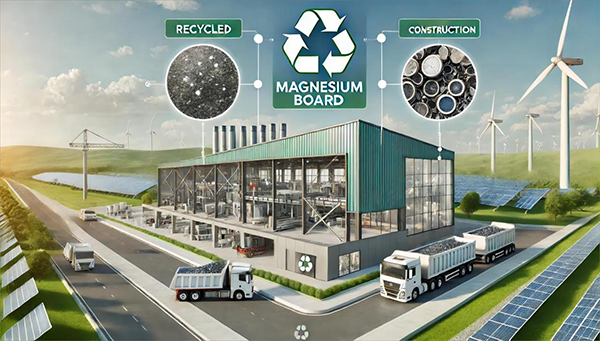Magnesium chloride board has very good toughness and fire resistance, but it also has problems such as moisture absorption, appearance of scumming, and corrosion of steel structures. In the field of steel structure enclosure board application, currently in Beijing and Tianjin and other places, the magnesium chloride board is prohibited and restricted. Due to its inherent defects, magnesium chloride board is difficult to enter the mainstream building materials sequence, and in the field of steel structure prefab construction, because of its corrosion of steel structures, it is absolutely prohibited to be applied.
Magnesium Oxide Sulfate Board is based on modified pure magnesium sulfate material, which completely retains the advantages of magnesium chloride board while eliminating its defects. It does not contain chloride ions, does not absorb moisture, and does not corrode steel structures. Magnesium chloride board is acidic, while magnesium oxide sulfate board is neutral or weakly alkaline, with a pH value between 7-8.
In June 2018, the Ministry of Industry and Information Technology issued documents and policies to include Magnesium Oxide Sulfate Board in the priority to encourage the development of emerging environmental protection green building materials (list Article 43). In October 2020, three ministries included it in the green building materials list database.
Performance Comparison Table of Magnesium Oxide Sulfate Board and Magnesium Chloride Board
|
Comparison Item |
Magnesium Chloride Board |
Magnesium Oxide Sulfate Board |
| Moisture absorption & appearance of scumming phenomenon | It is impossible to completely avoid the phenomenon of moisture absorption and appearance of scumming caused by free chloride ions, which is definitely occur under specific temperature and humidity conditions | No free chloride ions, no appearance of moisture absorption and scumming |
| Damage to decorative surface caused by moisture absorption & appearance of scumming | In a humid environment, moisture absorption and appearance of scumming will cause serious quality problems such as falloff of the coating, paint, wallpaper, blistering, fading, and powdering | No hidden risk of damaging the decorative surface |
| Application environment limitation caused by moisture absorption | The limitation of the application environment requirements is relatively high, needing to be applied in a dry environment or an indoor environment with constant temperature and humidity | No special requirement for the applied environment, can be widely used in indoor and outdoor decoration under various climatic conditions |
| Damage to the board quality & performance caused by moisture absorption | Repeated moisture absorption by periodic changes in climate and environment will have a huge potential impact on the board strength, toughness, and service life, with serious quality hazards such as subsequent deformation, cracking, and embrittlement | No potential quality hazards, stable quality performance |
| Corrosion on steel structure caused by free chloride ions | Free chloride ions seriously corrode steel structure components, cannot be used in various light and heavy steel structure housing projects | Does not contain free chloride ions, can protect the steel structure from corrosion by external acid and alkali, no safety risks of destroying the steel structure strength, can be widely used in various light and heavy steel structure buildings |
| Board Strength | High | High |
| Board Toughness | High | High |
| Water resistance performance | Poor (cannot be applied in humid environments) | High (can be applied in humid environments) |
| Limitations of application in the construction field | Whether it is corrosive to steel structure is the key | - |
| International market quality reputation | Most negative quality reputation in the international market is due to high chloride ion content causing moisture absorption and scumming problems | - |
The main technical index to distinguish the magnesium chloride board and magnesium oxide sulfate board is the chloride ion content. According to the Intertek test report data of physical and chemical performance made by us according to the Australian standard, the chloride ion content data is only 0.0082%.

Post time: Jun-14-2024

